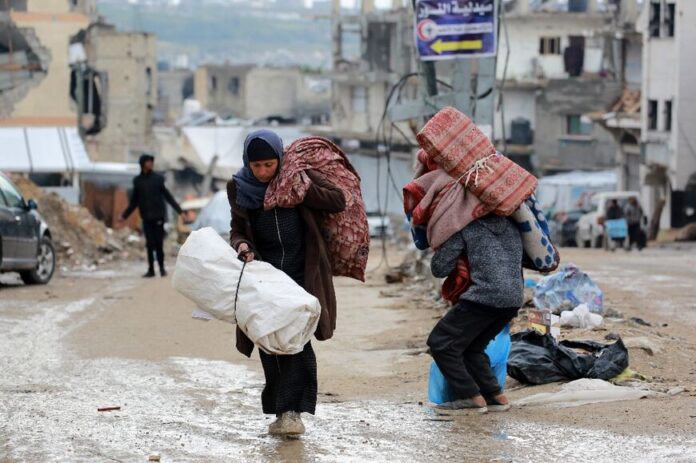In a dramatic move aimed at resolving the ongoing crisis in Gaza, the Fatah movement, led by Palestinian Authority President Mahmoud Abbas, has urged its Islamist rivals in Hamas to step aside and relinquish their control of the Gaza Strip. The call comes amid an ongoing conflict that has left thousands dead, a devastated Gaza, and stalled peace negotiations.
Monther al-Hayek, a spokesman for Fatah, delivered a stark message on Saturday, stating that Hamas must cede power to safeguard the “existence” of the Palestinian people in Gaza. He argued that continued Hamas control of the region would lead to the “end of Palestinians’ existence” and called for the group to show “compassion for Gaza, its children, women, and men.”
The appeal highlights the ongoing power struggle between Fatah and Hamas, two factions that have been at odds since 2007, when Hamas seized control of Gaza in a violent coup, forcing Fatah and the Palestinian Authority to retreat. Since then, numerous attempts at reconciliation have failed, and Hamas’s control has been a major obstacle in negotiations for a lasting ceasefire and peace agreement.
In a response to Fatah’s demands, Hamas indicated a willingness to explore different options for governance in Gaza but reiterated that it has no aspiration to remain in power. A spokesman for the group stated that Hamas is “prepared to accept any arrangement regarding the administration of Gaza that garners agreement,” adding that the group’s priority is ensuring “national consensus.”
Despite this, Hamas has refused to relinquish control over Gaza and disarm its forces, two key conditions that have been a sticking point in ongoing ceasefire negotiations with Israel. Hamas’s insistence on maintaining its military and governing control in Gaza has fueled tensions, with Israel’s leaders making it clear that any lasting peace deal must include the dismantling of Hamas’s military capabilities.
The conflict reached a new level of intensity following Hamas’s deadly October 7, 2023, attack on Israel, in which more than 1,200 people, mostly civilians, were killed, and over 250 people were abducted. In response, Israel launched a large-scale military offensive aimed at neutralizing Hamas targets, resulting in widespread destruction in Gaza.
The situation has become even more dire as both Israel and Hamas continue to hold hostages, including 59 individuals taken during the October attack. These hostages include both Israeli citizens and the bodies of individuals killed by Hamas. In January 2024, Israel and Hamas reached a temporary ceasefire agreement that allowed for the release of some hostages, but the broader issue of hostages and the long-term peace process remains unresolved.
The deal, which saw the release of 30 living hostages and eight bodies, also included the release of nearly 2,000 Palestinian prisoners by Israel. However, when the ceasefire expired in February, negotiations for a second phase broke down. The second phase of the agreement envisioned the full release of remaining hostages and prisoners, a permanent end to the war, and a complete withdrawal of Israeli forces from Gaza. However, Israel has insisted that it will not withdraw troops or end its military operations until Hamas is fully dismantled.
Hamas, on the other hand, has stood firm in demanding the continuation of the terms laid out in the January deal, which included a phased approach to hostages’ release and peace talks. Despite the military escalation and Israel’s refusal to engage in the second phase of talks, Hamas has repeatedly stated that it is committed to the terms of the agreement, arguing that Israel’s continued refusal to engage in discussions has only made the situation worse.
In response to Hamas’s continued refusal to cooperate, Israeli Defense Minister Israel Katz has warned of annexing parts of Gaza unless Hamas releases the remaining hostages. This stark threat reflects the deepening tension in the region and the failure of diplomacy to resolve the situation.
Israel’s military operations resumed in full force following the breakdown of the ceasefire negotiations, with airstrikes targeting Hamas infrastructure and ground operations in Gaza. These actions have led to more deaths and suffering among the civilian population, while Hamas has continued to fire rockets toward Israel in retaliation.
The threat of annexation and the continuation of military operations highlight the fragile state of peace in the region. With each side unwilling to make significant concessions, the prospects for a permanent ceasefire appear increasingly remote.
The international community has continued to call for an end to the fighting and for a negotiated resolution to the crisis. Human rights organizations have raised alarms about the humanitarian impact of the conflict, especially in Gaza, where thousands of civilians have died, and the infrastructure of the territory has been destroyed.
While efforts to mediate a lasting ceasefire have made some progress, the issue of Hamas’s governance remains a critical barrier. Many observers believe that any lasting peace agreement will require Hamas to relinquish its control over Gaza and allow for a more unified Palestinian authority to emerge. However, the political divisions between Hamas and Fatah, as well as the deep mistrust between Israel and the Palestinians, make such an outcome uncertain.
As the conflict continues to unfold, the calls for Hamas to step down and allow for a new phase of governance in Gaza will likely become a central issue in any peace talks. The future of Gaza, and the broader Israeli-Palestinian conflict, hinges on whether a resolution can be reached that addresses both the humanitarian needs of the Palestinian people and the security concerns of Israel.
The situation remains fluid, with both sides holding firm in their positions and the international community urging both Hamas and Israel to return to the negotiating table. For now, the fate of Gaza—and the future of the Palestinian people—remains uncertain as the world watches the ongoing struggle for peace in the region.

